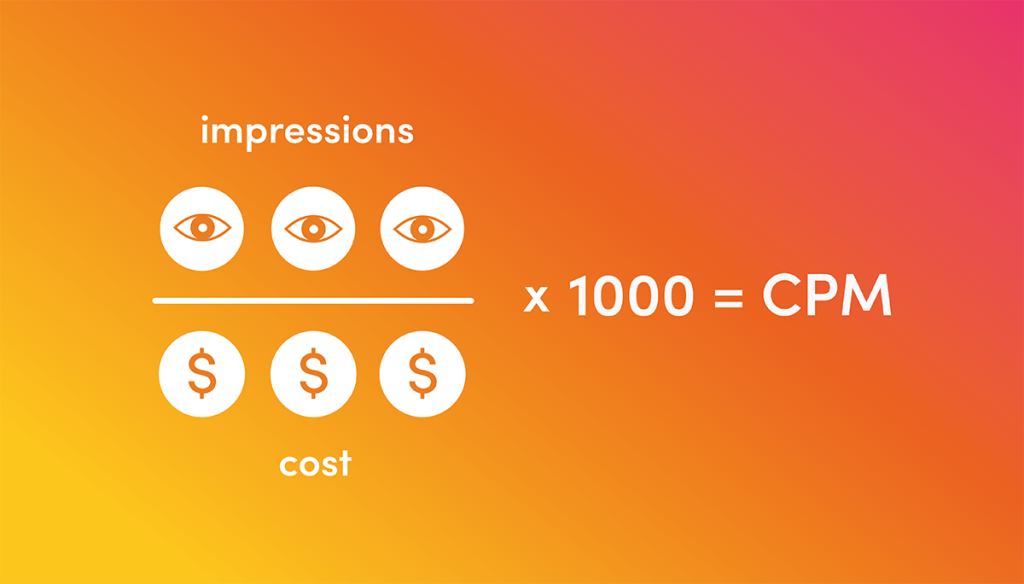Running an online advertising campaign, you might come across the term Cost per Mille (CPM), or cost per impression. This is a very useful option when it comes to running a Google Ads campaign, with CPM being a great way to maximise brand exposure and visibility.
People often refer to it as cost per mile, although mille is the correct term, which the linguists among you might have noticed is ‘one thousand’ in a variety of Latin-based languages.
This also makes more sense as a mile comes in at a fairly random 1609.33 meters – which is an awkward amount to calculate impressions with.
I digress… In fact, CPM is probably the most common metric to measure display advertising, with the term also used in publishing, TV advertising, and outdoor displays such as billboards.
In fact, in the days before Pay Per Click (PPC), the most common form of promotion would have been cost per mille/mile. After all, monitoring clicks on newspaper ads is not so easy.
In this article, we’ll take a look at a few points around cost per mile, including:
- What is CPM
- When to use CPM ads
- How to calculate CPM – or cost per impression
What is Cost per Mille (CPM)?
Very simply, Cost per Mille, or CPM, is the cost you pay per one thousand impressions (cost per 1000 impressions).
Google refers to this as viewable CPM (vCPM), which means that at least 50% of your ad needs to show on screen for one second or more. That, by Google’s reckoning, counts as an impression. Whether that counts as an impression in your book is another matter, but that is what you’ll pay for…
When it comes to video CPM, at least 2 seconds of your video need to play to count as an impression. Yes, even clicking “skip” video, after three seconds it will count as a view!
Using this model of display advertising on Google means that you don’t pay for any clicks on your ad, just for the number of times it is displayed. So if you have an ad that you think stands a high chance of attracting click-throughs, you could make your money go further with a CPM ad.
Of course, those one thousand impressions can soon rack up, and in fact, you’ll pay each time the ad is viewed by a single person. If you have a web user who sees your ad ten or twenty times a day, each of those views, or impressions, will count towards your total CPM. They might see your ad one hundred times and never click on it.
When to use CPM ads?
With the potential to get your ad seen so many times, it makes sense that the best time to use CPM is when you’re looking to maximise brand exposure.
For example, if you’ve launched a new product and you want people to know it’s out there, or if there is an event coming up soon.
Events like festivals, movies, conferences, and music concerts can all benefit from the cost per mille advertising model. Likewise, new apps or games, music releases, or local services can also see a boost in recognition and potential engagement with CPM advertising.
If you’re wondering if you should choose CPM or CPC (cost per click), this example could help to explain:
You’re running a marketing campaign, and your budget is $1000.
In 2018, the average cost per 1000 impressions was around $2.80, and the average cost per click was $0.75c.
For your $1000, based on 75c per click, you’re looking at around 1330 clicks. Which isn’t bad…
However, if you’re paying the average price of $2.80 per 1000 impressions, you can get your display ad seen around 357,000 times. If you get a click through rate (CTR) of 1% on those impressions, you’re potentially getting 3570 clicks for your $1000 – that’s nearly double the clicks for the same price.
Is CPM or CPC better? On these occasions, CPM ads might be your best choice.
- You have a current display ad campaign with a high click through rate (CTR)
- You’re aiming to maximise brand awareness or exposure
- You’re not aiming for specific conversions, such as visitors buying a product or signing new leads
How to calculate your cost per impression
Each of these useful CPM formulas will help you determine the cost of your advertising campaign.
Cost per impression
To calculate how much you’re paying for each impression on your campaigns, use this simple CPM formula.
Simply divide the total cost of your CPM campaign by the total amount of impressions to get your cost per impression.
AD SPEND / IMPRESSIONS = Cost Per Impression
For example:
$1000 ad spend / 357,000 impressions = $0.002.
Cost per one thousand impressions
To get your CPM cost (or the total cost per one thousand impressions), multiply the total by 1000.
(AD SPEND / IMPRESSIONS) x 1000 = Cost Per One Thousand Impressions

So although you’re paying a low price for individual ad impressions, how many of those have converted to site visitors?
Cost per click on a CPM campaign
To calculate your cost per click for your CPM marketing, follow this simple formula.
If 1% have clicked through, a total of 3570 people, then the formula would simply be:
Total spend/total click throughs = cost per click
So, in this example, we have paid:
$1000/3570 = $0.28c per click through.
Which is a significant improvement on the 0.75c CPC mentioned above.
Is CPM the best option for me?
It might seem like using the CPM model is a no-brainer, with our example showing a better click through rate for a lower cost.
However, our example is purely hypothetical, and in the real world, it isn’t always that simple.
First of all, in some tests, CPM marketing doesn’t seem to perform as well as paying for cost per click (CPC). If you’re thinking of trying CPM ads, it is worth running the same ad as both CPC and CPM to see which performs best.
Some have also suggested that using CPM gets your ad seen in better locations, including better websites.
Again, it’s worth running your own tests to see which campaign works best for you. It could even be that a combination of CPM strategies and CPC ads could work for you.
Maximising your ad impressions
One of the key problems with using CPM marketing can be that your impression counts, no matter who loads your page. In the case of fraudulent websites, they can load your ad thousands of times, with no human eyes ever setting sight on your ad.
This is particularly troublesome for video ad campaigns, which can have a relatively high cost, and can quickly impact your total campaign ad costs.
The problem of click fraud and ad fraud is a growing one and can affect any PPC campaign, no matter how you choose to run your ads.
Using ClickCease ensures that your ad impressions are strictly human – no bots, click farms, or other non-genuine sources of ad traffic.
Data shows that around 40% of all internet traffic is not human. These bots and data scrapers affect your ad views and clicks and cost you money but with zero chance of a conversion.
And, worse still, your ad platform algorithms can even retarget these fake accounts, causing a double wastage of your ad revenue.
ClickCease proactively protects your PPC ad campaigns, including pay per click and pay per impression. Our customers save, on average, 14% of their ad budget by blocking this invalid traffic.
Sign up for your FREE TRIAL of ClickCease to check out your ad traffic and see who (or what) is really interacting with your ads.
